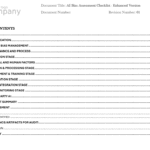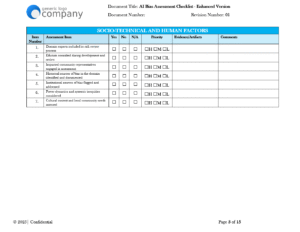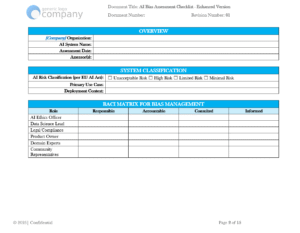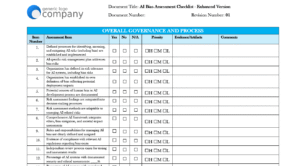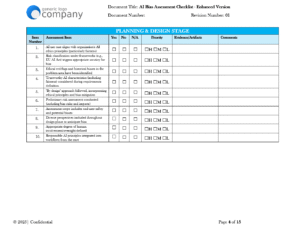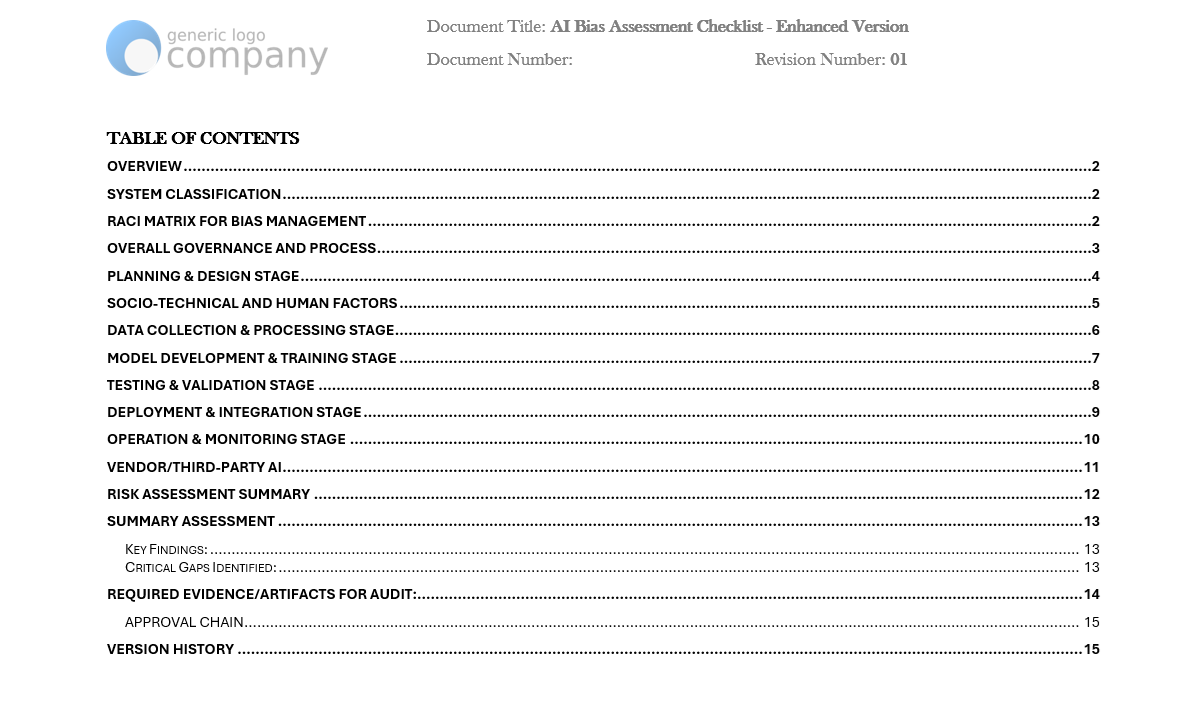
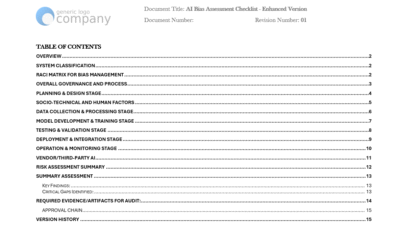
- Version
- Download
- File Size 0.00 KB
- File Count 0
- Create Date August 24, 2025
- Last Updated August 24, 2025
AI Bias Assessment Checklist
Assess and mitigate AI bias risks across planning, data, training, deployment, and monitoring with compliance-ready tools.
Reduce Bias and Stay Compliance: [Download Now]
Intro:
AI bias is one of the most pressing governance challenges for organizations deploying machine learning and generative AI systems. The AI Bias Assessment Checklist provides a structured, audit-ready framework to assess bias risks across the full AI lifecycle — from planning and design to monitoring and third-party vendor oversight.
Key Benefits:
-
✅ Lifecycle Coverage: Risk checkpoints across design, data, training, testing, deployment, and monitoring.
-
✅ Global Alignment: Built to align with EU AI Act, NIST AI RMF, ISO/IEC 42001, and OECD AI Principles.
-
✅ Governance Clarity: Includes RACI matrix for bias management roles.
-
✅ Audit-Ready: Evidence requirements, approval chains, and version history included.
-
✅ Vendor Risk Integration: Extends oversight to third-party and supply chain AI tools.
Who Uses This?
Compliance officers, AI ethics leaders, data science managers, and audit teams building trustworthy, explainable, and regulation-ready AI programs.
Why This Matters
The EU AI Act and other global frameworks emphasize bias and fairness as critical compliance requirements. Regulators expect evidence of bias identification, governance, and mitigation. This checklist provides organizations with a comprehensive, repeatable framework for bias risk management that enhances accountability, reduces ethical risks, and supports regulatory audits.
Framework Alignment
This checklist supports compliance with:
-
EU AI Act — Bias and fairness controls for high-risk systems (Articles 9, 10, 13).
-
NIST AI RMF — Integrates bias detection, risk scoring, and lifecycle monitoring.
-
ISO/IEC 42001 & 23894 — Governance and AI-specific risk management standards.
-
GDPR — Bias-related risks in automated decision-making and data handling.
-
OECD AI Principles — Human-centric AI, fairness, and accountability.
Key Features
-
System Classification: Categorizes AI system risk level (high-risk vs limited-risk under EU AI Act).
-
RACI Matrix for Bias Management: Defines accountability across ethics officers, data scientists, compliance, and community reps.
-
Governance & Oversight: Processes for identifying, mitigating, and monitoring bias risks.
-
Stage-Specific Assessments: Bias risk management across planning, design, data, training, testing, deployment, and monitoring stages.
-
Socio-Technical Factors: Incorporates domain experts, ethicists, and impacted community perspectives.
-
Vendor/Third-Party Oversight: Extends compliance to vendor AI models and supply chains.
-
Risk Assessment Summary: Consolidates key findings, critical gaps, and compliance gaps.
-
Approval & Accountability: Includes approval chain, sign-offs, and version history for audit trail.
Comparison Table
| Feature | Generic Bias Checklist | AI Bias Assessment Checklist (Pro) |
|---|---|---|
| Lifecycle risk checkpoints | Partial | Full coverage (design → monitoring → retirement) |
| Governance clarity | Vague | RACI matrix + approval chain |
| Framework references | None | EU AI Act, NIST AI RMF, ISO/IEC 42001 |
| Socio-technical considerations | Limited | Experts, ethicists, community reps |
| Vendor/third-party AI risks | Absent | Dedicated vendor bias assessment |
| Audit readiness | Minimal | Evidence log, compliance trail, version history |
FAQ Section
Q1: What frameworks does this checklist align with?
A: It references the EU AI Act, NIST AI RMF, ISO/IEC 42001, ISO/IEC 23894, GDPR, and OECD AI Principles.
Q2: Does this cover all stages of the AI lifecycle?
A: Yes. It includes checkpoints for planning, data, training, validation, deployment, monitoring, and retirement.
Q3: Does it address human and systemic bias?
A: Yes. The socio-technical section ensures human, cultural, and systemic sources of bias are considered.
Q4: Is it suitable for third-party AI systems?
A: Yes. It includes a vendor/third-party bias risk assessment module.
Q5: What evidence requirements are included?
A: The checklist identifies required audit artifacts, approval chains, and compliance documentation.
Q6: What is the best way to use these templates?
A: Documents are best viewed and used via Microsoft Word or Microsoft Excel. Formatting may not fully display in Google Docs or other editors.
Ideal For
-
AI Governance Committees
-
Compliance & Risk Officers
-
AI Ethics & Fairness Leads
-
Data Science & ML Engineering Managers
-
Legal & Audit Teams
-
Vendor Risk Management Functions

